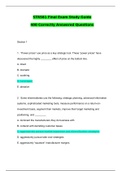Study guide
STR 581 - Strategic Planning and Implementation – Final Exam Study Guide (400 Correctly Answered Questions)(Verified answers, Already Graded A)
- Course
- Institution
STR 581– Final Exam Study Guide (Latest): University of Phoenix STR 581 – Strategic Planning and Implementation – Final Exam Study Guide 400 Correctly Answered Questions Section 1 1. “Power prices” use price as a key strategic tool. These “power prices” have discovered the highly _...
[Show more]



